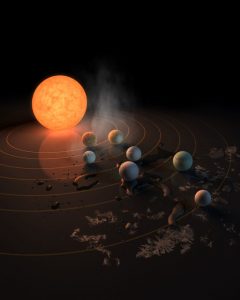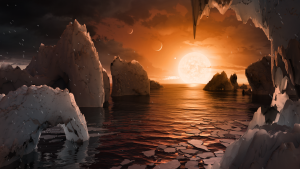 You may have guessed by now, I’m a total science nerd. The type who used to buy science magazines to read about the latest thoughts in string theory. So you can imagine my excitement about NASA’s recent announcement about the discovery of not one, but SEVEN, rocky planets around a neighboring star.
You may have guessed by now, I’m a total science nerd. The type who used to buy science magazines to read about the latest thoughts in string theory. So you can imagine my excitement about NASA’s recent announcement about the discovery of not one, but SEVEN, rocky planets around a neighboring star.
“Why is this so amazing?” you may ask. Well, first of all the technological aspects of it are insidiously complex. Planets do not create their own light, so scientists cannot see them directly for the glare of their stars. These exo-planets (the name given to planets around stars other than our sun) are detected by careful analyses of the star’s light. When an exo-planet passes in front of its star, the light flickers slightly. Our previous attempts to find exo-planets found mostly huge ones—Jupiter size and greater—because their dimming effect could be seen more easily. Rocky Earth-like worlds are significantly more difficult to see because they are so small in relation to their stars. In trying to describe the fine detail of the measurements involved in this most recent discovery, one scientist stated that it was akin to looking at a mosquito crossing in front of a car’s headlights from one mile away! And next year, NASA will launch a new telescope that will be orders of magnitude more powerful than Hubble. With it, they believe they will be able to analyze the atmospheres of these planets.
Beyond the technological aspect of this find is the nature of these new planets. Every star has a habitable zone, sometimes referred to as the Goldilocks zone—not too hot and not too cold. The Goldilocks zone is not so hot that water would evaporate from the surface of a planet and not so cold that water would turn to solid ice. Around our sun, 3 planets inhabit the Goldilocks zone—Venus, Earth, and Mars. Venus is on the hot side of the zone and has developed a runaway greenhouse atmosphere where temperatures hover around 800 degrees. Mars is on the cold edge of the Goldilocks zone where an exceedingly hot day in mid-summer at the equator may reach 70 degrees, but the nights are still a chilly 100 degrees below zero. The recently discovered seven rocky worlds are close enough to their star that 3 are definitely in the Goldilocks zone and a couple others are near the edges. So at least three of these worlds are in a zone where liquid water is possible. On Earth, everywhere there is water there is life.
Their location is also fascinating. These worlds are a mere 40 light-years from Earth. That’s trillions of miles to you and me, but within the galactic neighborhood, it’s like being one block over. The significance of this is that the makeup of our solar system may be the norm, and there may well be rocky planets in the habitable zone around a lot of stars.
Finally, these worlds are awe-inspiring to contemplate because, while they are Earth-like, they are very different from Earth. They orbit closely to a star that is much more dim than our sun. In fact, most of its radiation is in the infrared—light too low on the spectrum for humans to see. But the infrared light warms these worlds and casts them in a dim light that would give them salmon-colored skies. These planets are so close to their star and to each other that they dominate the sky. So to stand on any of these plane
ts would be to see a huge red orb in a salmon sky with two to three other worlds as large in the sky as our moon. I’m telling you, George Lucas couldn’t have thought that one up!
To summarize, for a geek like me, this is roller-coaster type fun. We were able to use our meager technology to prove the existence of a pack of Earth-size planets  around a star in our galactic neighborhood. Not only are they Earth-sized, but many are in the habitable zone. One or several of them may have warm seas beneath a salmon horizon dotted with huge views of nearby worlds. I get chills just imagining that scene!
around a star in our galactic neighborhood. Not only are they Earth-sized, but many are in the habitable zone. One or several of them may have warm seas beneath a salmon horizon dotted with huge views of nearby worlds. I get chills just imagining that scene!
Art work produced by NASA.gov.


 RSS - Posts
RSS - Posts